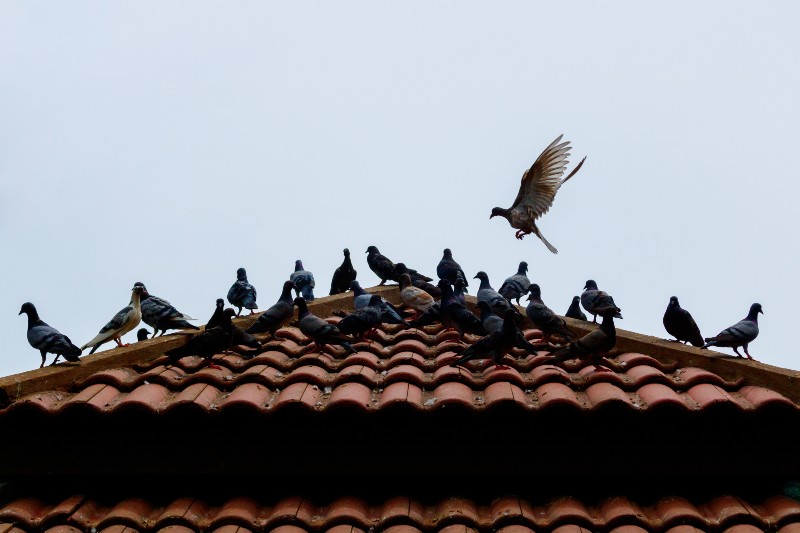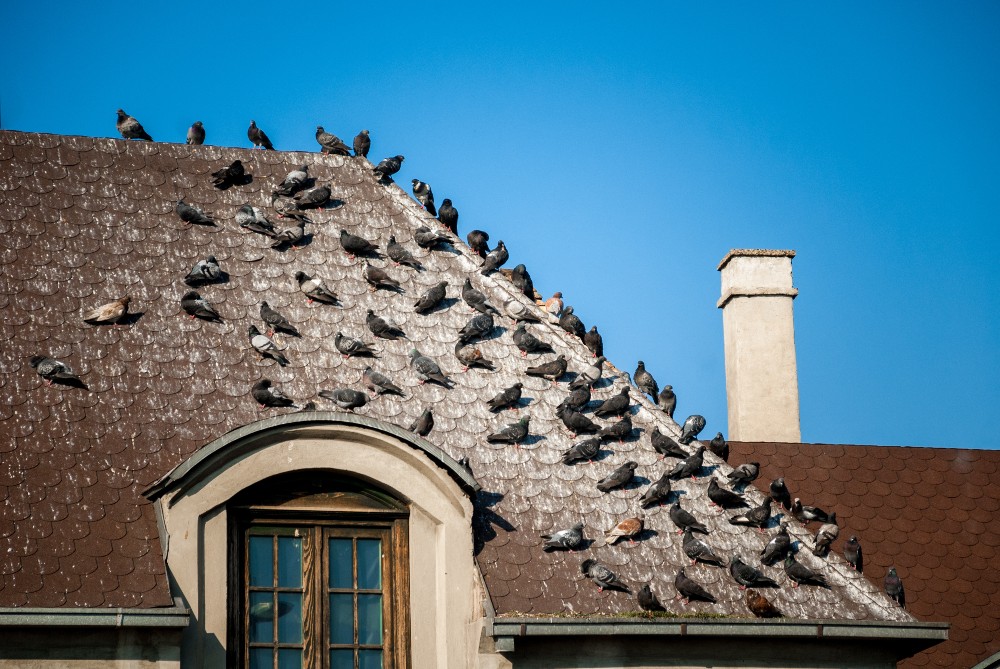Pigeons are more than a mere nuisance. In addition to carrying potentially harmful contagions, they can carry parasites, such as lice and bedbugs, which can infest a home. When they engage in nest-building, pigeons can also damage roofing and cause costly leaks. If you’ve noticed pigeons hanging around your roof, here’s how you can handle the problem.
Eliminate all standing water around your home. All birds, including pigeons, are drawn to water. Check for dripping outside spigots, leaking sprinkler systems, pools, clogged gutters, buckets and anything else that may serve as a reservoir where pigeons can drink or bathe.
Keep trash and food covered. If you live in a congested, densely populated urban neighborhood, this might be a challenge. Even still, you need to do your best to remove any edible attractants. Pigeons are drawn to free food, whether it’s human scraps or bowls of dog chow. Make sure your trash and recycling bins are covered and out of sight and bring in your pet’s food bowls when they are inside.
Consider a decoy. From fake snakes to false falcons, there are all sorts of scary decoys designed to frighten pigeons. Do they really work? It depends on who you ask. While some people swear by them, others consider them a waste of money. If you do decide to go this route, expect to have to swap out your decoys regularly. If you leave the same decoy in place for too long, pigeons will get acclimated to it and lose their sense of fear over time.
Try spikes. Pigeons usually prefer to roost and nest in specific places around a home, including the roof, ledges, window sills, chimney or under eaves. They also tend to hang out around balconies, patios, pool fences, decks and yards. Bird spikes are an effective, humane way to make these spaces less hospitable. As pigeons approach, they notice these unattractive obstacles and seek other landing spots.

Try some repellent. The most effective way to keep pigeons away from your roof is to create an unwelcome surface. Many homeowners have success using specially formulated bird repellent gels. Unfortunately, some gels can be quite messy, especially if you aren’t used to working with them. Do your research and read reviews before making a purchase to ensure that you choose a gel that will work best for your specific circumstances.
Place traps. You can purchase traps to catch pigeons on your rooftop or wherever else they are gathering. If you’re worried about the birds’ welfare, look for traps designed to catch the pigeons without causing injury. You can then drive several miles away and release the birds into a different environment. Don’t be surprised, however, if the pigeons find their way back to your home at some point in the future.
Consider reflective tactics. Reflective control involves the use of spinning wind-powered visual bird deterrents. Their mirror-like finishes use wind and sunlight to create a distraction zone that confuses pigeons and causes them to flee. Many people have great success with these devices, but there’s no guarantee that they will work in your specific circumstances.
Try ultrasonic devices. There are a variety of ultrasonic devices designed to irritate pest birds until they leave the area. Many people swear by the products, while others claim they do little or nothing at all. If you’re willing to pay the money, you can give one of these a try. That said, you’ll probably be better served spending your money on more proven pigeon deterrents.
Use netting. You can ward off pigeons by applying netting around areas they might want to nest. Obviously, you can’t cover your entire roof with netting. You can, however, use it in specific areas where you see pigeons congregating the most.
Unfortunately, pigeons and other pests can damage your roof over time, especially when they build nests that cause water to back up in your gutters and onto your roof. Over time, this can result in slow leaks which can lead to thousands of dollars in damage due to rot and mold.
If you have pigeons or other rooftop pests, get your roof inspected by a reputable local roofing contractor such as A to Z Roofing. For decades, A to Z has specialized in residential and commercial roofing, restoration and repair. A locally owned Colorado business, we’ve operated continuously throughout the Denver metro area and the entire Front Range for nearly a quarter of a century. During this time, we’ve served the needs of homeowners and local businesses, providing expert service using top-quality products. Contact our team of attentive professionals to learn how we can restore, repair or replace your damaged or aging roof.

